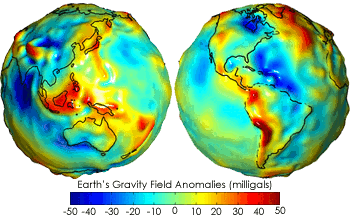
Local Gravity Variation
September 23, 2013 Isaac Newton not only discovered his law of universal gravitation, he also wrote about the practical consequences of the gravitational attraction between bodies. One theorem in his Principia (Principia, Proposition LXXI, Theorem XXXI) was a proof that gravitationally a uniform body can be replaced by a point mass at its center. In Newton's own words,[1]"... A corpuscle placed without the sphaerical superficies is attracted towards the centre of the sphere with a force reciprocally proportional to the square of its distance from that centre."
 |
| Figure from Proposition LXXI of Newton's Principia. (Click to view entire proposition.)[1] |
 | Earth's gravitational anomalies. The mean gravitational acceleration of the Earth is about 980 Gal, so the anomalies are small. (NASA image.) |
"This is a world-first effort to portray the gravity field for all countries of our planet with unseen detail... Our research team calculated free-fall gravity at three billion points – that's one every 200 meters – to create these highest-resolution gravity maps. They show the subtle changes in gravity over most land areas of Earth."[4]The highest gravitational pull can be found near the North Pole, while the smallest is at the top of Huascarán mountain in the South American Andes.[4] The new gravitational model is freely available to the public.[3] The following are some examples from the dataset.
 | Gravity variations in the region of India, Bangladesh and Tibet. (Still image from a YouTube video.)[5] |
 | Gravity variations at the Emi Koussi Volcano in the Sahara. (Still image from a YouTube video.)[5] |
 | Gravity variation over North America. Click for larger image. (Curtin University image.)[4] |
References:
- Isaac Newton, " Principia : The Mathematical Principles Of Natural Philosophy," English translation, via Archive.org.
- Christoph Schmid, "Newton's superb theorem: An elementary geometric proof," arXiv Preprint Server, January 31, 2012.
- Christian Hirt, Sten Claessens, Thomas Fecher, Michael Kuhn, Roland Pail and Moritz Rexer, "New ultrahigh-resolution picture of Earth's gravity field," Geophysical Research Letters, vol. 40, no. 15, doi:10.1002/grl.50838.
- Megan Meates, "Gravity variations much bigger than previously thought," Curtin University Press Release, September 4, 2013.
- GGMplus Earth gravity field model, YouTube Video.
- Christoph Schmid, "Newton's superb theorem: An elementary geometric proof," arXiv Preprint Server, January 31, 2012.